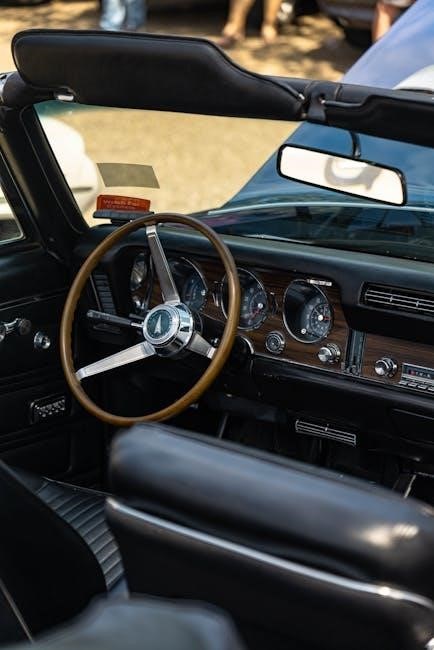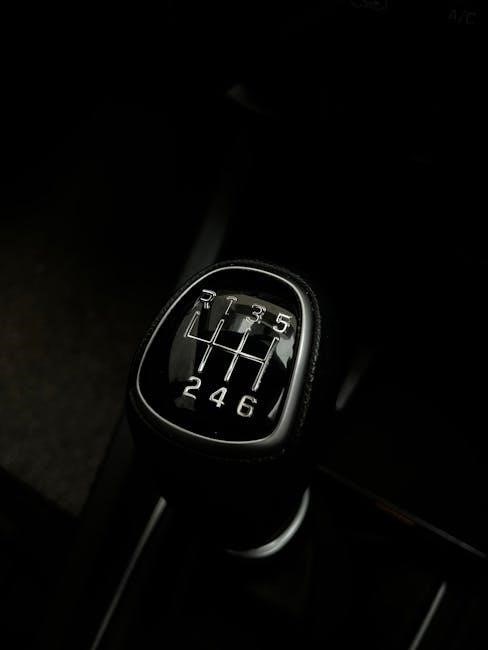A torque converter is a fluid-based component in automatic transmissions, enabling smooth power transfer from the engine to the wheels. It functions similarly to a manual clutch, allowing the engine to run independently of the transmission, ensuring seamless acceleration and gear shifts. The device uses hydraulic pressure to engage and disengage, providing torque multiplication for enhanced performance and efficiency in various driving conditions.

Definition and Basic Function
A torque converter is a fluid-based component in automatic transmissions, acting as a substitute for the manual clutch. It is positioned between the engine and transmission, enabling smooth power transfer while allowing the engine to continue running even when the wheels are stationary. Unlike a manual clutch, the torque converter uses hydraulic pressure to engage and disengage the engine from the transmission, ensuring seamless acceleration and gear shifts. Its primary function is to multiply torque during low-speed conditions, enhancing vehicle performance and driver convenience. This fluid coupling system eliminates the need for manual gear changes, providing a hassle-free driving experience.
Comparison with Manual Transmission Clutch
A torque converter in an automatic transmission serves a similar purpose to a manual clutch, enabling the engine to disconnect from the wheels when necessary. However, unlike the manual clutch, which requires driver input to press and release, the torque converter operates automatically using hydraulic fluid. This eliminates the need for manual gear shifting, offering greater convenience and ease of use. Both components allow the engine to run independently of the transmission, but the torque converter provides smoother transitions and torque multiplication, enhancing low-speed performance. This makes it ideal for city driving and heavy traffic conditions, where frequent stops and starts are common.
Working Principle of a Torque Converter
A torque converter uses fluid coupling to transfer power from the engine to the transmission. It employs an impeller and turbine to multiply torque, enabling smooth acceleration and gear engagement.
Fluid Coupling and Torque Multiplication
A torque converter operates through fluid coupling, where a transmission fluid transfers rotational energy between the engine and the transmission. The impeller (connected to the engine) spins the fluid, which then engages the turbine (linked to the transmission). This hydraulic interaction allows the converter to multiply torque, especially at low speeds, enhancing acceleration. A stator is often used to redirect fluid flow, maximizing torque output. This fluid-based system ensures smooth power transfer without direct mechanical connection, providing efficient torque multiplication and seamless gear transitions in automatic transmissions.
Hydraulic Pressure and Gear Engagement
In a torque converter, hydraulic pressure plays a crucial role in engaging gears and ensuring smooth transitions. The converter uses transmission fluid to create pressure, which activates clutches and bands within the transmission. This pressure allows the system to engage the appropriate gear based on driving conditions. The torque converter’s fluid coupling enables the engine to disengage from the transmission when stopping, similar to a manual clutch. Hydraulic pressure ensures that power is transferred seamlessly, providing efficient and responsive gear engagement without manual intervention. This system is essential for the smooth operation of automatic transmissions, allowing drivers to focus on steering and acceleration.

Types of Torque Converters
Torque converters vary, including locked and unlocked types, each suited for specific applications. They enhance performance in automatic transmissions, offering benefits like improved fuel efficiency and smoother gear transitions.
Locked vs. Unlocked Torque Converters
A locked torque converter engages the engine directly to the transmission, improving fuel efficiency and reducing slippage, especially at higher speeds. In contrast, an unlocked converter allows the engine to run independently, providing smooth acceleration and torque multiplication during low-speed maneuvers. The locked design is ideal for steady driving conditions, while the unlocked version excels in dynamic, stop-and-go situations. Modern vehicles often use multi-clutch systems to switch between modes, combining the benefits of both designs for optimal performance and efficiency across various driving scenarios.
Variable-Stall Torque Converters
Variable-stall torque converters adapt their stall speed to optimize performance across various driving conditions. Unlike fixed-stall converters, they adjust the torque multiplication dynamically, enhancing low-end torque for better acceleration and reducing slippage at higher speeds. This adaptability improves fuel efficiency and responsiveness, making them ideal for modern engines with varying power demands. The design incorporates advanced hydraulic controls and sensors to monitor and adjust torque delivery seamlessly. This technology bridges the gap between manual and automatic transmissions, offering the precision of a manual clutch with the convenience of an automatic system, thus providing a smoother and more efficient driving experience overall.
High-Performance Torque Converters
High-performance torque converters are engineered for vehicles requiring maximum power delivery and efficiency. Designed with reinforced components and advanced cooling systems, they handle high RPM and torque demands without compromising performance. These converters often feature specialized clutch packs and optimized stall speeds to enhance acceleration and responsiveness. They are particularly beneficial in racing and heavy-duty applications, where rapid power transfer and thermal stability are critical. By minimizing slip and maximizing torque multiplication, high-performance torque converters deliver superior drivetrain efficiency, making them a preferred choice for enthusiasts seeking enhanced performance without sacrificing reliability. Their robust construction ensures durability under extreme conditions, catering to both street and track use.

Advantages of Using a Torque Converter
A torque converter enhances drivetrain efficiency, providing improved fuel economy and smoother acceleration. It eliminates manual clutch engagement, reducing driver effort and offering a more convenient driving experience overall.
Improved Fuel Efficiency
A torque converter significantly enhances fuel efficiency by optimizing power transfer between the engine and transmission. It reduces engine strain during low-speed operations, such as city driving or heavy traffic, allowing the engine to operate within its most efficient RPM range. The fluid coupling mechanism ensures smooth acceleration without unnecessary fuel consumption. Additionally, modern torque converters incorporate locking mechanisms that engage during steady speeds, minimizing slip and maximizing energy transfer. These advancements enable vehicles to achieve better mileage and lower emissions, making torque converters a critical component for improving overall vehicle efficiency in both urban and highway driving conditions.
Enhanced Driver Convenience
The integration of a torque converter in manual transmissions simplifies driving by eliminating the need for constant clutch operation. This reduces driver fatigue, especially in heavy traffic or during frequent stops and starts. The torque converter automatically engages and disengages, allowing smooth transitions between gears without manual intervention. This feature is particularly beneficial for new drivers or those who prefer a more relaxed driving experience. Additionally, it enables seamless low-speed maneuvering, such as parking or reversing, without the risk of stalling. By automating the clutch function, the torque converter enhances overall driver convenience, making the vehicle more accessible and user-friendly in various driving scenarios.

Installation and Compatibility
Installing a torque converter in a manual transmission is non-standard, requiring custom adapters and engineering to ensure compatibility and proper function with the drivetrain system.
Manual Transmission Compatibility
Manual transmissions typically do not use torque converters, as they rely on a clutch to disconnect the engine from the transmission. However, in rare cases, custom setups may integrate a torque converter for specific performance needs, such as drag racing or high-torque applications. These modifications often require extensive engineering to adapt the torque converter to work alongside the manual transmission’s components, such as the clutch pedal and gear engagement system. While not standard, such configurations can enhance acceleration and torque delivery, though they may compromise the manual transmission’s traditional driving feel and simplicity. Compatibility depends heavily on the specific transmission and converter design.

Maintenance and Repair
Regular inspection of the torque converter is crucial to ensure optimal performance. Check for fluid contamination, worn bearings, or damaged clutch packs. Replace seals and bushings as needed to prevent leaks and mechanical failure, ensuring smooth operation and longevity of the component.
Common Issues and Solutions
Common issues with torque converters include slipping, contaminated fluid, and worn bearings. Slipping occurs when the fluid coupling fails, causing power loss. Contaminated fluid can damage internal components, requiring a full flush and replacement. Worn bearings or clutch packs may lead to vibration or noise. Solutions involve replacing the torque converter, flushing the transmission fluid, and inspecting the engine load. Regular maintenance, such as fluid checks and filter replacements, can prevent these issues. Addressing problems early ensures smooth operation and extends the lifespan of the component, avoiding costly repairs down the line.

Future Trends in Automotive Technology
Future trends include hybrid integration, smart torque management, and advanced materials for enhanced efficiency and compact designs, optimizing power delivery in next-gen transmissions.
Hybrid Systems and Smart Torque Management
Hybrid systems integrate torque converters with electric motors for enhanced efficiency, optimizing power distribution between engine and motor. Smart torque management employs electronic controls to allocate torque effectively, ensuring seamless operation and improved fuel economy. These systems leverage advanced materials and software to create compact, efficient designs. Future advancements may include intelligent algorithms that adapt to driving conditions, further refining torque delivery. This integration with hybrid technology promises to revolutionize automotive performance, combining the benefits of automatic and manual transmissions with the sustainability of electric power, setting a new standard for modern vehicles.
Integration with Advanced Transmission Systems
Modern automotive technology integrates torque converters with advanced transmission systems, enhancing performance and efficiency. Dual-clutch transmissions and continuously variable transmissions (CVTs) often incorporate torque converters to improve smoothness and responsiveness. These systems enable faster gear shifts and better torque delivery, particularly in hybrid vehicles. The torque converter’s fluid coupling complements electronic controls, ensuring seamless power transfer during gear changes. This integration reduces mechanical stress and optimizes fuel efficiency, making it ideal for high-performance and eco-friendly vehicles. As transmission systems evolve, the torque converter remains a critical component, bridging the gap between traditional and cutting-edge drivetrain technologies, ensuring superior driving experiences across various vehicle types.
